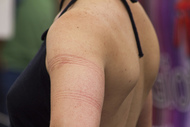- Home
- About Us
- TSPT Academy
- Online Courses
-
Resources
- Newsletter
- Business Minded Sports Physio Podcast
- Day in the Life of a Sports PT
- Residency Corner
-
Special Tests
>
-
Cervical Spine
>
- Alar Ligament Test
- Bakody's Sign
- Cervical Distraction Test
- Cervical Rotation Lateral Flexion Test
- Craniocervical Flexion Test (CCFT)
- Deep Neck Flexor Endurance Test
- Posterior-Anterior Segmental Mobility
- Segmental Mobility
- Sharp-Purser Test
- Spurling's Maneuver
- Transverse Ligament Test
- ULNT - Median
- ULNT - Radial
- ULNT - Ulnar
- Vertebral Artery Test
- Thoracic Spine >
-
Lumbar Spine/Sacroiliac Joint
>
- Active Sit-Up Test
- Alternate Gillet Test
- Crossed Straight Leg Raise Test
- Extensor Endurance Test
- FABER Test
- Fortin's Sign
- Gaenslen Test
- Gillet Test
- Gower's Sign
- Lumbar Quadrant Test
- POSH Test
- Posteroanterior Mobility
- Prone Knee Bend Test
- Prone Instability Test
- Resisted Abduction Test
- Sacral Clearing Test
- Seated Forward Flexion Test
- SIJ Compression/Distraction Test
- Slump Test
- Sphinx Test
- Spine Rotators & Multifidus Test
- Squish Test
- Standing Forward Flexion Test
- Straight Leg Raise Test
- Supine to Long Sit Test
-
Shoulder
>
- Active Compression Test
- Anterior Apprehension
- Biceps Load Test II
- Drop Arm Sign
- External Rotation Lag Sign
- Hawkins-Kennedy Impingement Sign
- Horizontal Adduction Test
- Internal Rotation Lag Sign
- Jobe Test
- Ludington's Test
- Neer Test
- Painful Arc Sign
- Pronated Load Test
- Resisted Supination External Rotation Test
- Speed's Test
- Posterior Apprehension
- Sulcus Sign
- Thoracic Outlet Tests >
- Yergason's Test
- Elbow >
- Wrist/Hand >
- Hip >
- Knee >
- Foot/Ankle >
-
Cervical Spine
>
- I want Financial Freedom
- I want Professional Growth
- I want Clinical Mastery
 The literature over the past several years has demonstrated the direct link between scapular dyskinesias and shoulder dysfunction. For example, if someone lacks Serratus Anterior motor control, it can manifest as the pathoanatomic diagnosis of 'shoulder impingement syndrome.' Good SA strength is essential for normal upward rotation and posterior tipping of the scapula. Clinically when a patient lacks SA motor control, the patient may present with shoulder pain, neck pain, and/or thoracic or rib dysfunction. In this patient scenario, the upper trapezius, scalene muscles, rhomboids, and levator scapulae become dominant and hypertonic. Dominance pattens feed upon themselves until pain or significant dysfunction arises. How the Patient will Compensate for Scapular Weakness Since the scapular stabilizers are not functioning properly, the body develops creative compensations to complete specific movements. First, the patient may demonstrate excessive lower thoracic extension. With increased lower thoracic lordosis, the thoracic paraspinals become dominant. Each time the scapular stabilizers attempt to contract, the thoracic spine locks into extension and powers through the movement using the paraspinals. It will appear that the patient is hinging from the thoracolumbar junction. To retrain this pattern, you need to focus on core position. Have the patient find a neutral spine, then work on retraining the specific scapular dyskinesias. Retraining will often need to happen in a gravity eliminated position (sidelying, prone, or AAROM in supine) because these patients do not know how to activate the scapular stabilizers. A second compensation is excessively using the shoulder external rotators without any scapular stability. This patient will have very dominant Teres Major and Minor muscles and Latissimus Dorsi. A neutral posture for them is retracting the shoulders without any upper thoracic extension. They appear to be in decent postural position, but in reality are lacking proximal/central stability. I often think about this compensation similar to someone who is hamstring dominant. The client appears to have good strength, but they are using prime movers to gain a false sense of stability. In both scenarios, find neutral torso alignment first. This means engaging the deep Transversus Abdominus activation from a long torso position. From here, work on breathing mechanics, ribs mechanics, and engaging deficient muscles. Make sure the patient is not tipping their lower ribs to the pelvis to find a neutral core! Check out the video below which demonstrates the 2 common postural compensations. -Jim Heafner PT, DPT, OCS OPTIM COMT Instructor
1 Comment
Mary Z
9/1/2021 07:11:45 am
This sounds like me. Of course I'm compensating for muscels that have been damaged or which do not receive proper nerve signals. What confuses me is how my therapist is supposed to get me to use these very same damaged muscles to fix the problem.
Reply
Leave a Reply. |
Dr. Brian Schwabe's NEW Book in partner with PaleoHacks!
Learn residency-level content on our
Insider Access pages We value quality PT education & CEU's. Click the MedBridge logo below for TSPT savings!Archives
July 2019
Categories
All
|






 RSS Feed
RSS Feed